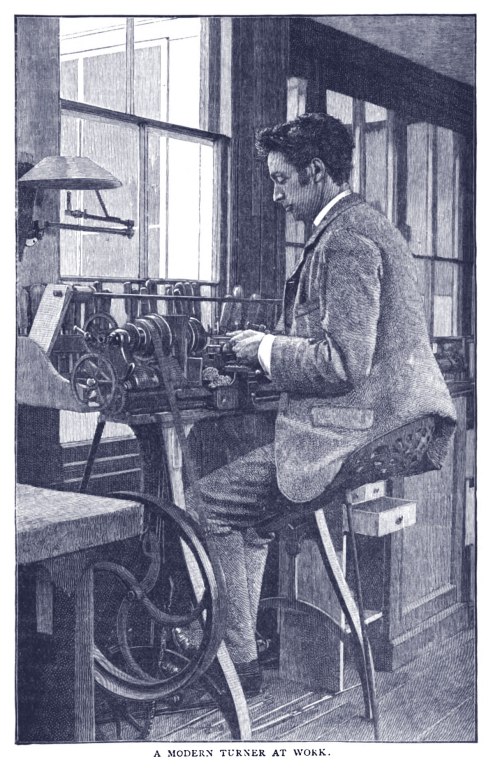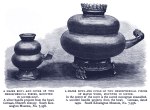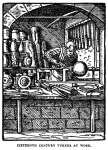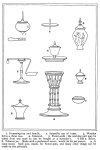
(An Open Letter)
Yes, we have all been reading Sir Walter Scott’s journal, and are noway surprised but every way pleased to hear that you have taken to heart his pathetic lament when in old age winter restricted his outdoor exercise, and he regretted that he was no mechanic to solace himself with a turning-lathe or joiner’s bench. And so you have invested in an American lathe with velocipede action, which you drive sitting, hoping to get as much exercise in an hour of an evening at home as by a six-mile run on a tricycle.
Meantime, by way of beginning, you have broken the points of your whole kit of tools and crumpled up two leaves of the quick-feed pinion, and with them three teeth of the rack, to say nothing of smashing a finger-nail with the jaw of the indispensable scrollchuck (by the by, a rubber fetlock-ring effectually guards against this last disaster), and the net result of your labours is some bushels of shavings with a couple of pounds of brass and iron dust. Naturally at this point you desire an opinion on your prospects as a craftsman.
Well, the first thing that strikes one is that you would have done better to include a grindstone as part of your equipment; that, in fact, you can’t get on a step farther without one. And then as to the crucial question of exercise. You have found, I suppose, that an hour at the lathe by no means represents a six-mile run, because three parts of the time are spent in fiddling with chucks and screws and other paraphernalia, and only the outstanding quarter in driving ahead.
Now a lathe may be regarded in either of two very different aspects; as an exceedingly useful tool, the means of accomplishing a great variety of work; or as an end in itself, the central object of an ever-increasing army of appliances desirable rather for their own mechanical prettiness than as the instruments for perfecting any product at all comparable with themselves for beauty or elaboration.
Whatever else may be said for it, I don’t think this second use, if use it be, of a lathe is at all likely to afford you pedalling equivalent to a six-mile run. It remains, then, to inquire what kinds of work will give you continuous turning in fairly large proportion to the necessary standing about and preparatory work, seeing that you require for recreation that manual or at least pedal labour should preponderate over thought and worry.
You say the powers that be suggest your beginning by replacing a broken towel-rail, which however is thirty inches long while your lathe takes but twenty between the centres. If that’s all you want, the primitive pole lathe would serve your turn excellently well. Not that the pole lathe is to be sneered at. I remember an old farm carpenter who used it to turn axe-handles which it would puzzle you to imitate with all the appliances of a London tool-shop to your hand, to say nothing of flutemakers who use no other.
Indeed there is much to be said for the historical method in learning the turner’s art. One little bit of modernization I would permit, the substitution of a rubber door-spring for the cumbrous and troublesome pole, otherwise it is just the same instrument you see figured in Plumier or Bergeron, best known to most of us by the reproductions in Holtzapfel.
You only need a pair of coach-screws for the centres, carried by blocks of wood which can easily be clamped to any stout bench or table, together with some sort of tool-rest, and for a few shillings you have a serviceable lathe; indeed for soft wood-turning the handling of the tools, though pretty much the same as on the other lathes, is slightly easier; there is not quite so pronounced a tendency to make those ugly jags and unforeseen spirals on the nearly-finished work which are such a terror to the beginner, so if you mean to obey and attack that towel-rail you may as well rig up a dead-centre lathe.
It is one’s bounden duty, according to the tradition of the elders, to urge you to begin your career as a practical turner by making a long cylindrical ruler, with hand tools of course, and “if at first you don’t succeed,” &c. But as you are sure not to succeed in this simple but difficult operation within, say, the first three months of your amateur apprenticeship, and as I certainly cannot give you that example which is better than precept, I can’t press you to persevere with this opening.
Far less can the ordinary man ever hope to turn a common salad bowl with a hook tool, another absurdly simple task till you try it. Patient ingenuity may tattoo blocks of ebony with endless complications of geometric curves, but certain simple forms of rotary work far excel such niggling in sheer beauty of skilful handicraft, most fascinating to watch, and to the amateur even a chance success in practising these is a joy long remembered. Such are pot-throwing, metal-spinning, hand-chasing of screws, and soft wood-turning.
Though I doubt if your lathe is exactly the best for any one of these, yet you could hardly have come by a more generally serviceable tool. It is true that the mandril is not likely to be stiff enough for much metal-spinning, and I don’t think the most inveterate deviser of combination tools has produced a pot-thrower’s attachment for an amateur’s lathe, while for soft wood-turning the sitting position is mostly inconvenient. But it is a far more wholesome exercise than the usual one-legged treading, and the screw-cutting gear will save you the painful acquisition of the art of screw-chasing by hand, and then after all, what besides that towel-rail do you want to make?
Of course there are many odd jobs for which a lathe is handy, besides a considerable amount of chuck and tool-making, which the enterprising amateur will see his way to without making the accumulation of apparatus his main purpose; but to ensure the daily six-mile spin which health demands, something beyond odd jobs is required. You want some straight-a-head work that you can take up day after day with little more contrivance and thought than goes to a ride in the Row or on the humbler tricycle.
It is no use prescribing a course for you, but one can suggest a few suitable articles of manufacture which will give a fair proportion of turning to pottering, and when finished will not be mere useless cumbrances. One article for which I find a seemingly unlimited demand in the home circle is a substitute for the small woolly mats of olden days in the shape of little platters to put under hot milk jugs, vases, flower pots and other enemies of polished tables; just flat discs with a trifling raised moulding to the rim.
You can cut out a number of blanks from a piece of half-inch stuff, glue a bit of paper to the back of each, glue that again to a rough wooden face-chuck, and you will find that a platter four inches across of such woods as sycamore or walnut will give you a good six-mile run, unless you keep your tools a deal sharper than I manage to.
No doubt, before long, the powers that be will ordain that some of the platters must be oval, and then you will be let in for making an oval chuck; a wooden one will serve well enough, and as an oval chuck and an eccentric chuck of this rough sort are easily convertible, you will thus find yourself possessed of the elements of so-called ornamental turning; and I have to own, at whatever apparent cost of consistency, that I do occasionally like to incise a geometrical pattern in the face of a platter. At all events the apparatus is as cheap as the product, and one must allow that the construction of additional apparatus is an instructive resource, provided it is not the sole object.
However, figured or plain, one may tire of platters and even of napkin rings, though what do you say to one of ebony with a spiral groove therein, inlaid with twisted silver wire? Boxes of many sorts and sizes are satisfactory, though it is astonishing how few ideas seem to occur to the professional designers of such things.
But they too may become a drug in the home market, and as cabinet-making, which should offer a wider range of work, presents us amateurs with the problem of making several pieces exactly to length and pattern,which, be it said with bated breath, is not precisely our forte, we need not sorrow overmuch if the Early English of Tottenham Court Road have made this branch of “art manufacture” as intolerable as they have made the ill-used word “art” itself. But if you must attempt something of the sort let me commend to your notice the old German spinning wheels as admirable models of this class of design.
Why not try your hand at a pair of brass candlesticks; at all events it will give you two jobs— first the making of the wooden patterns for the foundry, and then the finishing of the brass. Herewith are outlined sketches of two of the best of the old shapes; you will find it much less trouble in finishing if you get the stems cast solid; but if you want to do the thing properly and save weight to the utmost, you may turn a model for the core exactly corresponding to the pattern for the stem, but three-sixteenths of an inch less in diameter. The flat base will easily cut out of an inch-and-half deal plank, the other would take a three-inch plank, but is perhaps more readily turned of harder wood the other way of the grain. Remember to have a square rebate inside by which to chuck the brass-castings, and spirit-varnish them as soon as finished, getting them into the foundry without delay, as they soon warp and twist.
Or you may make several pairs of wooden candlesticks for the same labour. There is an exquisite little pair of cedar wood in the South Kensington Museum delicately carved in parts which, with the carving modified to suit one’s skill, would be an excellent model.
Actual copying is only fair for children, but here is a memory sketch of the French master’s work, and if you can re-design it from that, preserving the grace of the original or adding a grace of your own, you will have made good your right to the use of the idea. It is scarcely worth while to cut the octagon base on the lathe, though of course it can be done. Pear tree would be a good material; cedar of Lebanon is not easily come-at-able, and the cedar of which skiffs are built is troublesome to turn.





Besides candlesticks the equipment of the writing-table suggests several objects for the turner’s skill; familiar as inkstands and boxes for matches, stamps or string, and paperweights, or the less obviously easy construction of a postal balance. For a rough job, how about a set of ninepins? The ball would be a nice test of your skill. But really, if you can come down to puerilities, there is nothing like tops for the turner. Get the reprint of Professor Perry’s British Association lecture, and if your dormant instincts for play and for science are not awakened, I am sorry for you.
W. A. S. Benson
The English Illustrated Magazine – 1892
—Jeff Burks